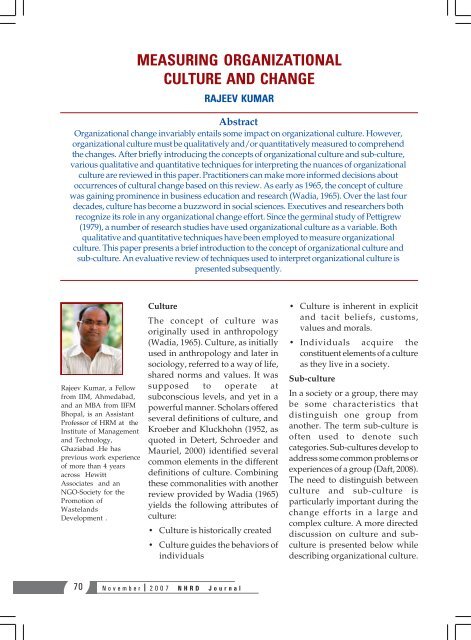NHRD Journal - National HRD Network
NHRD Journal - National HRD Network
NHRD Journal - National HRD Network
You also want an ePaper? Increase the reach of your titles
YUMPU automatically turns print PDFs into web optimized ePapers that Google loves.
MEASURING ORGANIZATIONAL<br />
CULTURE AND CHANGE<br />
RAJEEV KUMAR<br />
Abstract<br />
Organizational change invariably entails some impact on organizational culture. However,<br />
organizational culture must be qualitatively and/or quantitatively measured to comprehend<br />
the changes. After briefly introducing the concepts of organizational culture and sub-culture,<br />
various qualitative and quantitative techniques for interpreting the nuances of organizational<br />
culture are reviewed in this paper. Practitioners can make more informed decisions about<br />
occurrences of cultural change based on this review. As early as 1965, the concept of culture<br />
was gaining prominence in business education and research (Wadia, 1965). Over the last four<br />
decades, culture has become a buzzword in social sciences. Executives and researchers both<br />
recognize its role in any organizational change effort. Since the germinal study of Pettigrew<br />
(1979), a number of research studies have used organizational culture as a variable. Both<br />
qualitative and quantitative techniques have been employed to measure organizational<br />
culture. This paper presents a brief introduction to the concept of organizational culture and<br />
sub-culture. An evaluative review of techniques used to interpret organizational culture is<br />
presented subsequently.<br />
Rajeev Kumar, a Fellow<br />
from IIM, Ahmedabad,<br />
and an MBA from IIFM<br />
Bhopal, is an Assistant<br />
Professor of HRM at the<br />
Institute of Management<br />
and Technology,<br />
Ghaziabad .He has<br />
previous work experience<br />
of more than 4 years<br />
across Hewitt<br />
Associates and an<br />
NGO-Society for the<br />
Promotion of<br />
Wastelands<br />
Development .<br />
Culture<br />
The concept of culture was<br />
originally used in anthropology<br />
(Wadia, 1965). Culture, as initially<br />
used in anthropology and later in<br />
sociology, referred to a way of life,<br />
shared norms and values. It was<br />
supposed to operate at<br />
subconscious levels, and yet in a<br />
powerful manner. Scholars offered<br />
several definitions of culture, and<br />
Kroeber and Kluckhohn (1952, as<br />
quoted in Detert, Schroeder and<br />
Mauriel, 2000) identified several<br />
common elements in the different<br />
definitions of culture. Combining<br />
these commonalities with another<br />
review provided by Wadia (1965)<br />
yields the following attributes of<br />
culture:<br />
• Culture is historically created<br />
• Culture guides the behaviors of<br />
individuals<br />
• Culture is inherent in explicit<br />
and tacit beliefs, customs,<br />
values and morals.<br />
• Individuals acquire the<br />
constituent elements of a culture<br />
as they live in a society.<br />
Sub-culture<br />
In a society or a group, there may<br />
be some characteristics that<br />
distinguish one group from<br />
another. The term sub-culture is<br />
often used to denote such<br />
categories. Sub-cultures develop to<br />
address some common problems or<br />
experiences of a group (Daft, 2008).<br />
The need to distinguish between<br />
culture and sub-culture is<br />
particularly important during the<br />
change efforts in a large and<br />
complex culture. A more directed<br />
discussion on culture and subculture<br />
is presented below while<br />
describing organizational culture.<br />
70<br />
November 2007 <strong>N<strong>HRD</strong></strong> <strong>Journal</strong>
















